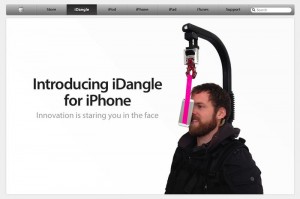When the biggest brand in consumer electronics revealed its newest ground-breaking product, the Apple Watch (so far, the brand is breaking its “i” naming trend, staying away from the moniker), earlier this month, the internet went wild. The long-rumored watch — speculated on since 2010 — was finally available for consumers to view, and purchase, sometime early next year for $350. A small price to pay compared to the $1,500 and awful aesthetic of Google Glass and with voice- and touch-activated functions that allow users to check email, call contacts, look at photos, track exercise, and yes, tell time, all with stylish interchangeable bands.
Now, wearable technology is nothing new. We’ve had bluetooths since 2000 and digital hearing aids, technically a form of wearable tech, since the late ‘80s, but in fact, as Mashable reports, it was tech geeks in the ‘60s and ‘70s trying to cheat casinos who are credited with pioneering some of the first forms of wearable tech.
But, outside of computerized wristbands and even rings, mostly used to track fitness levels, while wearable technology has quickly been gaining ground, nothing has broken into the laymen’s market yet. Yet. Looking at how Apple changed the cellular communication market, making smartphone ubiquitous with cell phone, or really, even phone, and considering their enormous database of loyal customers, if anyone is primed to crack open this market, it’s Apple.
And, the consumers are ready for it. According to a poll done by GlobalWebIndex, 71% of 16- to 24-year-olds would like to own wearable tech, which the poll defined as smart watches, smart wristbands or Google Glass. And according to the same study, 64% of global internet users say they have worn or would like to wear a piece of wearable tech, with men dominating that number at a 69% affirmative rate and women at 56%.
As marketers and creatives, we’re always being asked to anticipate “the next big thing” or being bombarded with what the media has dubbed “the next big thing” (Anybody employing holographic teleconferences yet? Didn’t think so.), so sometimes, we can be most blind to designing our campaigns for emerging platforms. Just look at how long it’s taken us to crack the mobile market, and how clueless many big brands still come across on social media, and you’ll see that as much as this industry loves something shiny and new, they don’t always understand how to use it to best serve them or how soon to become a part of it. The best strategy we can have for wearable technology is to figure out ways to experiment with it now. Maybe it’s a one-off stunt as part of a bigger campaign or maybe it’s an in-house experiment. Whatever we do, we need to do it fast because as soon as that Apple Watch gets strapped to your client’s wrist, they are going to be asking how you can get them a marketing presence on it.
Wearable technology is going to be a whole new platform to us. A more intimate version of mobile that will open many doors, and present an equal number of challenges, but isn’t that the fun of it? In this business, I’ve seen enough tech trends come and go to see that wearable tech isn’t going anywhere. Whether it comes in the form of an Apple Watch, a more accessible version of Google Glass or the product of a startup founded by someone who hasn’t started high school yet, soon, it’s going to be second nature to us to strap on our tech. We don’t need to anticipate this as a trend, we need to embrace it as a new part of our lives.
